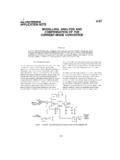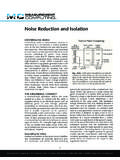Transcription of Review of Circuits as LTI Systems - Ted Pavlic
1 ECE 209: Circuits and Electronics LaboratoryReview of Circuits as LTI Systems Math Background: ODE s, LTI Systems , and Laplace TransformsEngineers must have analytical machinery to understand how Systems change over time. For example,springs and dampers in car suspension Systems absorb kinetic energy after road disturbances and dissipatethe energygentlyover time. Electronic filters protect Circuits from large input transients in a similar , engineers need to know how to choose components Systems and ODEs:The motion of many physical Systems can be modeled knowing only a fewof its derivatives.
2 For example, a car s position over time can be described well knowing its velocity oracceleration. So we focus on thelinear time-invariant(LTI) systemx(t)LTI Systemy(t)which has inputx(t) ( , height of terrain under the car) and outputy(t) ( , height of passenger s seat).By our assumption that all we need are a few derivatives of the inputand the output, then a typicalordinarydifferential equation(ODE) that might model such a system isy + 3y + 2y=x x(1)wherey andy are the first and second derivatives of signaly(t).
3 Given a known inputx(t), we would liketointegratethis differential equation to find an expression ofy(t) that is only in terms oft. Then we can seehow to adjust our design parameters so thaty(t) has a desirable shape ( , even with a bumpyx(t) roadsurface, the car seaty(t) stays in one place). So we need a convenient way tosolvethis differential Decomposition:Assume thatxcan be broken into two parts so thatx(t) =x1(t) +x2(t). Byinspection, if I can solveEquation (1)for the responsey1tox1alone and the responsey2tox2alone, thenthe responseytoxwould bey1+y2.
4 Further, imagine that I could find a set of functions such that: When a function in the set is an input toEquation (1), the output is simple to find. Every useful inputx(t) can be expressed as a sum (or integral) of functions from this this case, solving ODE s likeEquation (1)would be trivial. Before even knowing the inputx, I could findthe solution to the ODE for every function in this special set. Then when I finally do know my input , I justsum up the relevant prototypical acomplex exponentialfunctionf(t),Aestwheres, +j is acomplex numberwith real part and imaginary part , andAis also a complex number.
5 Just as with a purely real exponential function,f (t) =sAest=sf(t) and f(t) dt=1sAest=1sf(t).(2)That is, for an exponential ( ,Aest), differentiation is identical to multiplication bysand integration isidentical to division bys. So complex exponentials turn ODE calculus ( , df /dtand fdt) into simplealgebra ( ,sfandf /s). Moreover, this property holds whensis purely real or and the Characteristic Response:Because everyx(t) =x(t) + 0, then the zero- input caseis important to us, and we should handle it first.
6 These zero- input effects will be a part of every solutionregardless of the input , and so the output trajectory for zero input is called thecharacteristicorintrinsicortransientr esponse of the system . We will assume that this output is made up of complex exponentials,and so we lety(t),Aestandx(t),0, which turnsEquation (1)intoAest(s2+ 3s+ 2)= 0,(3)and so we must solve for values ofsthat make this equation true. Fortunately,|Aest| 6= 0 for alls, and sothe roots of thecharacteristic polynomials2+ 3s+ 2,s= 1ands= 2,(4) Document Source code 2007 2011 by Theodore P.
7 PavlicCreative Commons Attribution-Noncommercial LicensePage 1 of 4 ECE 209 Review of Circuits as LTI Systemsboth solveEquation (3). Hence, thezero- input transient responseofEquation (1)isy0(t) =Ae 1t+Be 2twhereAandBare complex numbers that correspond to different initial conditions. Becausee t 0 ast for all <0, theny0(t) 0 ast . So as long as the roots inEquation (4)are very negative,theny0(t) will decayquickly, and we can usuallyignore its general, the roots of the characteristicpolynomial are calledeigenvalues( , intrinsic values or characteristic values ).
8 When therealpartof the eigenvalues arenegative, then the characteristic response will continuously decay. Such LTI systemsare calledSTABLE because aspects of the output that are not due to the input will always decay to have components that grow and eventually dominate the Response to an input :Now we assume that the LTI system isstable( , its eigenvalues havenegative real parts) so that we can focus on the system after itstransient response has decayed out. So weconsider the inputx(t),XestwhereXis some complex number.
9 It seems reasonable to guess that theoutputy(t) =Y estwhereYis some complex number. If our guess is wrong, there will be no solution, andwe will try something else. So under these assumptions,Equation (1)becomesY est(s2+ 3s+ 2) =Xest(s2 1).Again because|est|6= 0 for alls,YX=s2 1s2+ 3s+ 2.(5)That is, for a given inputXest, we can find the outputY estby scalingXby the ratio inEquation (5).Thistransfer functionrepresents the impact of the system on any individual complex exponential. Thedenominator of the transfer function is the characteristic polynomial of the system .
10 The system s eigenvaluesare calledpolesbecause the transfer function s denominator iszerothere, and so the transfer function smagnitude is like a tent being pulled toward the sky by each of its poles. So given a transfer function, wemust make sure its denominator roots ( , poles) have negative real example, ifx(t),e 2tcos(3t), then the input can easily be expressed as a sum of complex exponen-tials usingEuler s formula. That is,x(t) =e 2tcos(3t) =e 2tej3t+e j3t2=12e( 2+j3)t+12e( 2 j3)t,which is a kind of generalized Fourier series of the signal.







